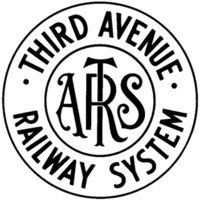
The Interborough Rapid Transit Company (IRT) was the private operator of New York City's original underground subway line that opened in 1904, as well as earlier elevated railways and additional rapid transit lines in New York City. The IRT was purchased by the city in June 1940, along with the younger BMT and IND systems, to form the modern New York City Subway. The former IRT lines are now the A Division or IRT Division of the Subway.

Getty Square is the name for downtown Yonkers, New York, centered on the public square. Getty Square is the civic center, central business district, and transit hub of the City of Yonkers. A dense and growing residential area, it is located in southern Westchester County, New York. The square is named after prominent 19th-century merchant Robert Getty.

The Fifth Avenue Coach Company was a bus operator in Manhattan, The Bronx, Queens, and Westchester County, New York, providing public transit between 1896 and 1954 after which services were taken over by the New York City Omnibus Corporation. It succeeded the Fifth Avenue Transportation Company.

The Third and Lexington Avenues Line, also known as the Third Avenue Line, is a public transit line in Manhattan, New York City, running from Lower Manhattan to Fort George in Washington Heights. Originally a streetcar line, it now consists of the M98, M101, M102, and M103 bus routes, operated by the New York City Transit Authority. The M98 bus route operates on Third Avenue between East 65th Street and East 127th Street, although it previously continued to 32nd Street. The M101, M102 and M103 bus routes run southbound on Lexington Avenue north of East 24th Street.
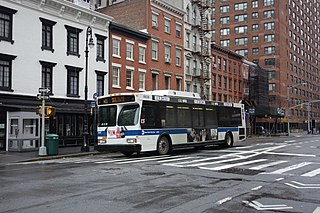
The Ninth and Tenth Avenues Line or Ninth Avenue Line is a surface transit line in the New York City borough of Manhattan, running mostly along Ninth Avenue and Amsterdam Avenue from Lower Manhattan to Manhattanville. Originally a streetcar line operated by the Manhattan and Bronx Surface Transit Operating Authority, it is now the M11 bus route operated by the New York City Transit Authority.

The Eighth and Ninth Streets Crosstown is a public transit line in Manhattan, New York City, running mostly along Eighth Street, Ninth Street, Tenth Street, and Christopher Street through the West Village, Greenwich Village, and East Village. Originally a streetcar line, it is now the M8 bus route, operated by the New York City Transit Authority.

The Columbus Avenue Line is a public transit line in Manhattan, New York City, running mostly along Columbus Avenue, 116th Street, and Lenox Avenue from Lower Manhattan to Harlem. Originally a streetcar line, it is now the M7 bus route, operated by the New York City Transit Authority, a division of the Metropolitan Transportation Authority.

The M9 is a local bus route that operates along the Avenue C Line, in Manhattan, New York City. The route runs mostly along Essex Street and Avenue C from Battery Park City to Kips Bay. Originally a streetcar line, the Avenue C Line is now part of the M9 route, as well as the M21, which operates on the Houston Street Line. Both the Avenue C and Houston Street segments were served by a single route, the M21, until June 2010. The M9 and M21 are operated by the New York City Transit Authority, and based out of the Michael J. Quill Depot.
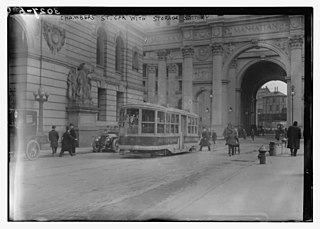
The New York Railways Company operated street railways in Manhattan, New York City, between 1911 and 1925. The company went into receivership in 1919 and control was passed to the New York Railways Corporation in 1925 after which all of its remaining lines were replaced with bus routes.
The Brooklyn and North River Line, operated by the Brooklyn and North River Railroad, was a trolley line in Manhattan and Brooklyn, New York City, United States. Its route ran from the Desbrosses Street Ferry across Lower Manhattan via the Canal Street Crosstown Line, over a pair of tracks on the east side of the Manhattan Bridge, and to the intersection of Flatbush Avenue and Fulton Street in Downtown Brooklyn. Operation in Manhattan and over the bridge was with conduit electrification, while in Brooklyn it used overhead trolley wire, switching at a plow pit.

The Broadway Line is a surface transit line in Manhattan, New York City, running mainly along 42nd Street and Broadway from Murray Hill to Harlem. Formerly a streetcar line operated by the Third Avenue Railway, it is now the M104 bus route operated by the New York City Transit Authority, a subsidiary of the Metropolitan Transportation Authority. This bus route no longer runs along the entire route of the former streetcar.
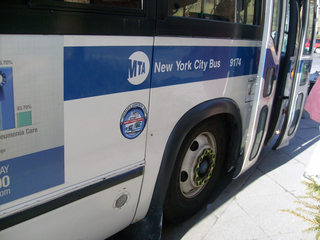
MTA Regional Bus Operations operates local and express buses serving New York City in the United States out of 29 bus depots. These depots are located in all five boroughs of the city, plus one located in nearby Yonkers in Westchester County. 21 of these depots serve MTA New York City Transit (NYCT)'s bus operations, while the remaining eight serve the MTA Bus Company These facilities perform regular maintenance, cleaning, and painting of buses, as well as collection of revenue from bus fareboxes. Several of these depots were once car barns for streetcars, while others were built much later and have only served buses. Employees of the depots are represented by local divisions of the Transport Workers Union of America (TWU), particularly the TWU Local 100 or of the Amalgamated Transit Union (ATU)'s Local's 726 for all depots in Staten Island, 1056 for Casey Stengel, Jamaica, and Queens Village Depots, 1179 for JFK & Far Rockaway Depots, and 1181 for Spring Creek Depot.
The Surface Transportation Corporation was the bus-operating subsidiary of the Third Avenue Railway in New York City which operated under that name following the conversion of the streetcar lines in Manhattan and the Bronx to bus service between March 1941 and August 1948. On December 17, 1956, the corporation was bought by Fifth Avenue Coach Lines, Inc. as part of its acquisition of the Third Avenue Railway, and its routes placed under a newly created operating subsidiary, Surface Transit, Inc.
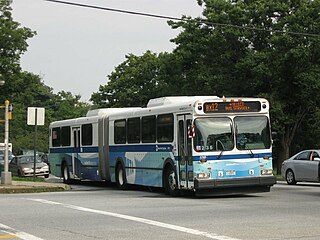
The Bx12 is a public transit line in New York City running along the 207th Street Crosstown Line, within the boroughs of Manhattan and the Bronx. The line runs along 207th Street in Upper Manhattan and along the continuous Fordham Road and Pelham Parkway in the Bronx.

The New York Railways Corporation was a railway company that operated street railways in Manhattan, New York City, United States between 1925 and 1936. During 1935/1936 it converted its remaining lines to bus routes which were operated by the New York City Omnibus Corporation, and now operated by the Manhattan and Bronx Surface Transit Operating Authority. The organization was the successor to the New York Railways Company which was in receivership.

The Williamsburg Bridge Plaza, sometimes called Washington Plaza or the Williamsburg Bridge Transit Center, is a major bus terminal and former trolley terminal located at the foot of the Williamsburg Bridge in the New York City borough of Brooklyn, one block west of the Brooklyn-Queens Expressway (I-278). It is situated by the boundaries of Broadway, Havemeyer Street, Roebling Street, and South 5th Street, south of the LaGuardia Playground. It contains five bus lanes, and serves as a terminal for numerous MTA New York City Transit Authority bus routes of Brooklyn and Queens that start and end their runs there.

The 42nd Street Crosstown Line is a public transit line in Manhattan, running primarily along 42nd Street in Midtown Manhattan. Originally a streetcar line, it is now the M42 bus route, operated by the MTA Regional Bus Operations under the New York City Transit Authority brand.

The Bx15 and M125 bus routes constitute the Third Avenue/125th Street Line, a public transit line in New York City. The Bx15 runs between Fordham Plaza and the Hub in the Bronx, running primarily along Third Avenue. The M125 runs between the Hub in the Bronx and Manhattanville in Manhattan, running along Willis Avenue in the South Bronx and along 125th Street in Harlem, Manhattan.

The 86th Street Crosstown Line is a bus line in Manhattan, New York City, running mostly along 86th Street on the Upper West and Upper East Sides of Manhattan. Originally a streetcar line, it now comprises the M86 Select Bus Service bus line.
